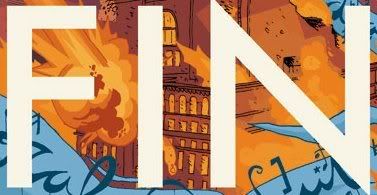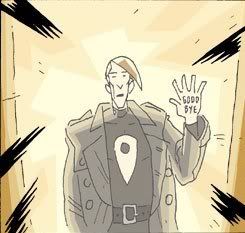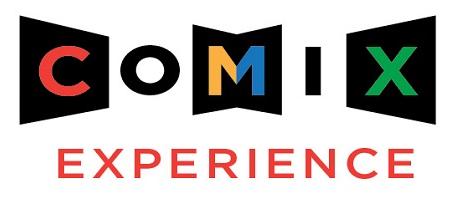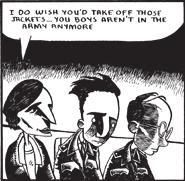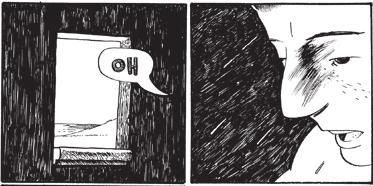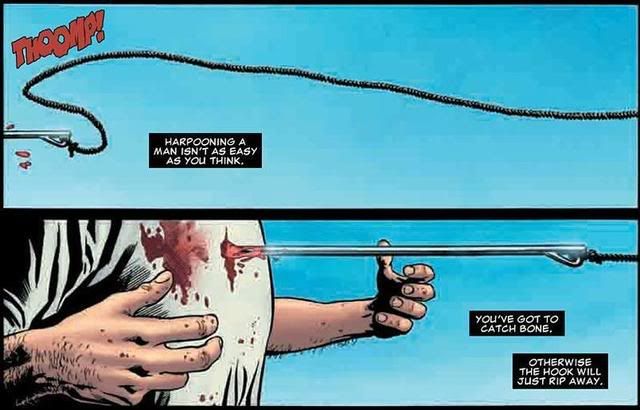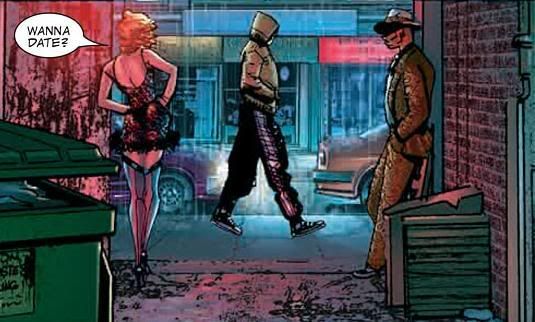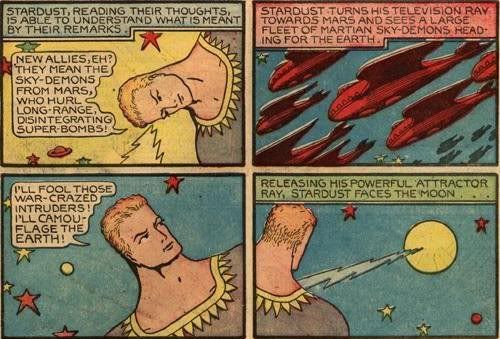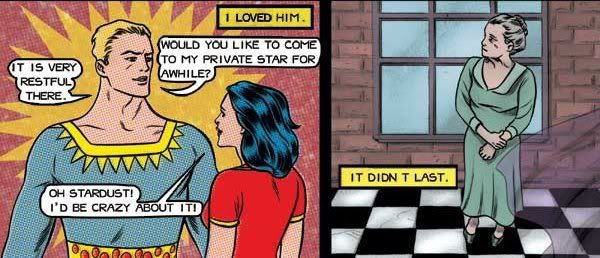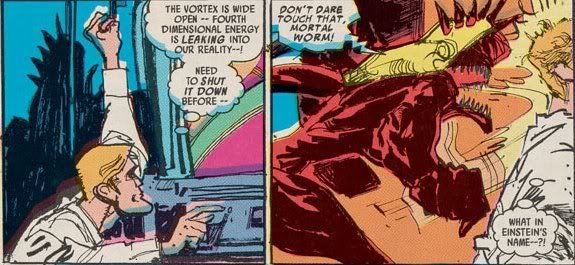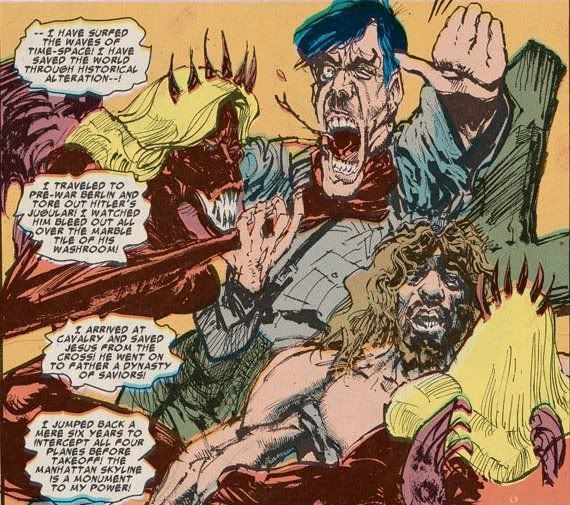I've been sick. I've been busy. I've been sick of being busy, am I right, people? Anyways: comics.
The Next Issue Project -- Fantastic Comics #24: Jog already reviewed this, but I'm feeling redundant since Jog already reviewed this, but I'm feeling redundant since Jog already reviewed this but COMEDY! This is a sort-of tribute to the public domain comics of the 1930's and 1940's, specifically a Fox Syndicate Features title, Fantastic Comics. The character lineup is an exact recreation (down to batting order) of, inter alia, 1940's Fantastic Comics #12, available online.
Sometimes it's fun; sometimes it feels like when people in their 20's wear suits and go dancing to big band music and say things like You're so money and you don't even know it or whatever.
1940's Fantastic Comics #12 was pretty different in comparison. Consider the Samson story from that issue. Apparently, Samson is a lesser Hugo Hercules figure, with a little Tarzan tossed in. Basically, a half-naked dude runs around wrecking shit.
The 1940 story opens on Samson throwing a factory through the air for no reason. Here and throughout the comic, he's accompanied by a half-naked boy companion named David. Just a young half-naked boy companion, so paging Dr. Wertham. Cut to Samson waving a pole at an ice cream salesmen. Random men tell him to put the pole down, so he puts the pole down (YEAH, LADIES, VALENTINE'S DAY CAN BE ALL YEAR LONG, THAT'S HOW WE DO IT ON THIS BLOG)(p.s. I'm 12 years old). Then a messenger is shot in front of his house.
End of page one.
Samson rips open a wall at the local newspaper, finds out from the editor of the local newspaper that "spies are trying to wreck this country". So he swims to ... somewhere, and fights those goddamn spies. He learns about the spy plot to blow up the Panama Canal. Samson races to stop them in a plane. The plane crashes because it's out of gas. Then, Samson arrives at the Panama Canal, and throws a freighter into the air before it can blow up the Canal. Then, he find outs that 70 men are being "smuggled in on the Underground Railway". So Samson steals a boat, finds a submarine, carries the submarine out of the water, then snaps the submarine in two with his hands-- FUCK YOU, SUBMARINE. Samson races to the spy secret headquarters which blows up. Samson fucks up a locomotive, then races into the "Secret Valley", busts through a wall, gets electrocuted, etc. The bad guys cut Samson's hair (robbing him of his powers!) and start to have bondage-fun with the naked-boy companion (remember him? I wish I didn't!), but luckily, Samson's hair grows back three panels later and the naked-boy companion is saved.
At which point, Samson just starts fucking wrecking shit indiscriminately.
He destroy a dam, throw a cannon at shit, finds a long-lost pyramid, wrecks that motherfucker-- FUCK YOU, PYRAMID! Finally, he finds the bad guy: oh my God, it's the editor of the local newspaper! FUCK YOU, JOURNALISM MAJORS. Finally, the last panel:

The End. That's a thirteen page story. It's funny how people claim kids today have no attention spans because of MTV, when their grandpas used to down these 13 page condensed nonsense shots. Maybe short attention spans aren't MTV's fault. Maybe it's the High-Fructose Corn Syrup. Quick, to a centrifuge!
The stories in #24 move a little slower. But: I'm glad they're not like comics from 1940 because (a) the stories in the 1940's FANTASTIC COMICS sure seem like they're mostly inane shit and (b) that Samson story made me tired.
Anyways, #24's a hang-out comic. Talented people hang out, and you get to see them have some fun. The stakes are pretty low-- if you appreciate the style, well, the battle the book seems to want to win is more than half won.
By that standard, I had a good enough time. The Ashley Wood story is pretty clever: Wood ignores the source material and makes more of an exhortation than a story, but it works, especially concluding a book with its fair share of near-misses and not-even-close-es storywise. Still, I'd say Jim Rugg & Brian Maruca's Capt. Kidd story was the most "successful" for me: a few minor visual nods to the 40's aside, Capt. Kidd feels like a Rugg-Maruca character when they're done with him. I'd read more of their Capt. Kidd.
But, hell, it's tough for the creators in this book: the distinction between appreciating the past, and fetishizing it, building a house on a shaky foundation-- well, that's a pretty thin line. I just think Rugg/Maruca avoided the latter the most successfully. If the relative merits of the stories in this first edition of the Next Issue Project indicate anything, I think it's that future creators in this format might want to consider avoiding overly fixating on the style of lousy Golden Age comics and maybe try sticking with good stories about fun characters. I think those might come back into fashion someday. I think that gum you like is going to come back into style.
Iron Man #25: I started picking up this comic a while back-- I don't know, something made me curious, maybe the movie, maybe the art, maybe how they've positioned the character in Civil War, maybe being an overgrown man-child, whatever. It's one of those books they made all serious-- it's all serious now. It's something in-between a pretty-cool espionage comic and an Ashley Judd movie. Sometimes it works; sometimes it's totally ridiculous. And it varies page-by-page because... well, because they're trying to do a serious espionage comic about Iron Man.
The creators get some mileage from the classic Marvel formula of outwardly strong, kinetic characters who are internally fucked up and full of self-pity and regret. They write Tony Stark with all these wacky mental problems -- that always seems to work. On the other hand, they try to write him as an underdog, as a minor government figure at the mercy of petty bureacrats, which is hard for me to square with the character's recent history.
I guess not everyone relies on that formula-- the Millar/Hitch FF appears to be about a group of well-adjusted, happy, rich celebrities who enjoy hot sex with beautiful people. One issue in, anyways, it's enormously self-satisfied and boring-- or as I like to call it, a Mark Millar comic! COMEDY! Maybe Millar has his own formula I haven't picked up on yet-- his stuff always seems like a bunch of loud noises to me... well: which I suppose can be fun when the noises are loud enough to drown everything out (see, e.g., Enemy of the State).
Anywho-- with Iron Man, it's amusing that even with a recap page, no one can be bothered to explain what Extremis is to me. Every other word in this goddamn comic is Extremis. I've read about four issues of the book now, and somehow I still have no idea what the shit an Extremis is. I swear, they mention Extremis on every page of this fucking comic book except the recap page. Why not just type out a link to wikipedia on the recap page? Why not just tell me about Iron Man's summer vacation? Tell me more, tell me more, did he get very far? Tell me more, tell me more like does he have a car? Et cetera.
This issue falls in the ridiculous camp more often than usual. The "detective work" in the issue ... I haven't read the book for a very long time so how Tony Stark solves the never-goddamn-ending mystery for me was a groaner. I'd have to think it'd be like getting punched in the balls if I were more invested in the comic, but who knows? At least, I think both fans and casual readers will be happy for any indication that such an extremely long and drawn-out arc might be approaching something resembling a conclusion. Most importantly, I hope Ashley Judd likes me.
Also, the Maria Hill character turns up in one panel to remind readers that the most horrible character a Marvel writer can conceivably imagine is a successful, aggressive woman; eventually they're going to kill her or rape her or kill-rape her or Skrull her or something, and the discomfort I feel pretty much every single time that character appears on a page will be gone.
Other Crime Comics: Scalped #14 has a swell 3-page stretch where the main character beats up a pickup truck. I particularly enjoyed that part, but seeing as the whole arc's based on some heavy-duty spoilers, let's leave it at that. So, yeah, SPOILER WARNING: don't get too attached to the pickup truck. '76 #2 has pretty much the exact same strengths and weaknesses of the first issue-- nothing about it seems to have much to do with the 1970's, but the Cool half is good fun exploitation sleaze while the Jackie Karma half starts to build up its street-mythology. Everyone in this comic is named Gino, though...? The Chemist #2 is dominated by a large action sequence. It all still feels a little by the numbers, but the lady sidekick abuses some prescription sleep medication halfway through the issue-- I liked that.
James Stokoe's Wonton Soup is not a crime comic, so much as a competitive-cooking-slash-space-opera hybrid. Stokoe's a contemporary of Brandon Graham and Corey Lewis, so you can expect that same kind of thing: high-energy rambling with the focus on fun drawings moreso than particularly intricate or meaningful narratives. Stokoe is maybe a little more laid back about his pacing, though. Not a lot happens slowly, but the scenery's fun enough, basically. It's definitely gentler and more focused on atmosphere than Stokoe's gonzo action webcomic, 41 Stories, which is where I think a lot of us were introduced to his work.
I was extra-happy the main characters were truckers-- I've always thought it was a shame there weren't more comics in the trucking genre (except Marvel's U.S Archer which I never read). You know: if it weren't for Star Wars, Smokey and the Bandit, starring Mr. Burt Reynolds, would have been the highest grossing film of 1977. Also: I think there should be more comics about moonshiners, like Burt Reynolds in White Lightning.
Also: I think there should be a comic called Sharky's Machine, about Atlanta vice cop Tom Sharky, and his machine, and their lives and loves. Who do I write letters to?
![]() The Umbrella Academy: Apocalypse Suite #6 (of 6):
The Umbrella Academy: Apocalypse Suite #6 (of 6):